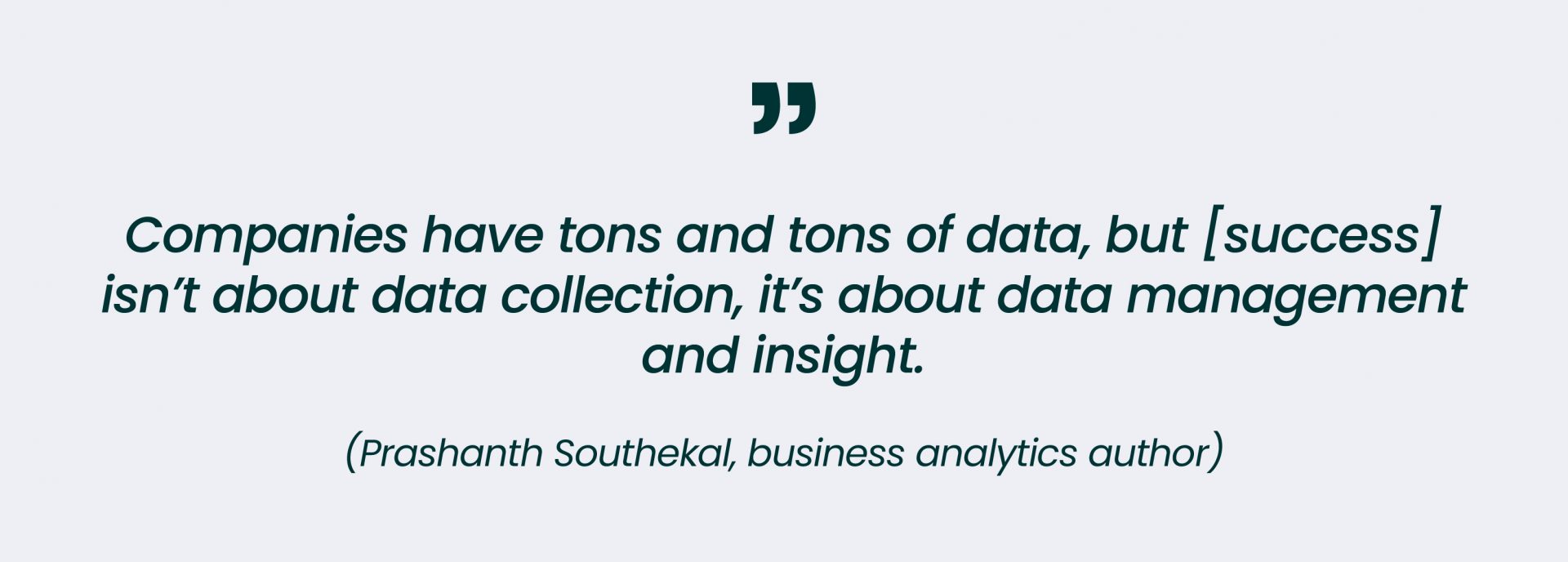Traditional data strategies are no longer effective in today’s environment, where businesses use real-time data. Companies need to catch up on tasks such as backups and database management. Poor data quality and fragmented data hinder decision-making and fail to provide helpful insights. Plus, security concerns arise when it is needed to integrate data from different sources.
But what should businesses do with these tons of data and concerns related to them? Data management strategy is a modern approach that breaks down data barriers, equips teams with powerful analytics tools, keeps data safe and governed, and enables data-driven decision-making.
However, crafting an effective data strategy is not a simple task. It requires constructing a robust and scalable data infrastructure and incorporating the best practices to benefit from data.
Luckily, you’re reading our article, which means you’ve come to the right place. We’ll share how to build an efficient data management strategy and how you can grow by harnessing the power of your data.
What Is a Data Management Strategy?
A data management strategy is a comprehensive approach to handling data assets. It involves data collection, processing, storage, and ensuring data quality and security. The integration of data management tools into a data strategy makes it more powerful, allowing for transforming raw data into valuable insights.
In 2023, only 53% of companies had a formalized data strategy. However, this situation is changing as companies become more aware of its importance. Businesses want to derive value from their data, and an effective data management strategy can assist them.
Ready to make your operations smoother and keep your data safe? Contact us to create a customized data management strategy and use your resources more efficiently.
Data Management Strategy Components: Functions and Roles
The efficacy of a data management strategy depends on the integration of all its components, which are incredibly vital for your business. Let’s focus on its components, functions, and specialists involved in data management strategy.
Data architecture for aligning technologies with business goals
Any data management strategy should begin with data architecture, which defines and influences how data is collected, integrated, transformed, stored, and used. As a rule, a data specialist is responsible for this area, focusing on building a robust infrastructure to ensure data delivers business value.
From selecting the right software and hardware solutions to deciding between on-premises and cloud-based platforms, a data architect has you covered. As a result, you can easily access the information you need for data-driven decisions.
Data modeling for creating meaningful data entities
Data modeling is discovering and representing datasets in a form known as a data model. Data scientists and data modelers are responsible for this component of a data management strategy. They team up closely with stakeholders to identify valuable data and build data models to represent core business concepts, their attributes, and the relationships between them. For example, products or customers can refer to business data entities.
Business-driven data modeling is a growing trend. Companies are shifting from comprehensive models to more business-component perspectives. Nearly 52% of organizations already use data models, but many are still struggling with data management issues. So, data modeling should become the aspect of data management strategy to get the most out of large volumes of data.
Database administration to ensure data availability
Data availability is a vital aspect of data management. A database administrator is responsible for ensuring data availability by performing tasks related to managing databases. Their duties also include creating database designs and updating systems to maintain security.
Database administration should be included in your data management strategy to ensure the high performance of your database and faster response time.
Data integration and interoperability for better connectivity between systems
You obtain data from various sources such as e-commerce platforms, CRMs, web and mobile analytics tools, and payment processors. But these data sources often don’t interact with each other due to being in various formats. That’s why you may need data integration and interoperability to connect all these systems and turn them into a single dataset to use them effortlessly and extract valuable insights. A data architect or engineer can assist you with this aspect of your data management strategy.
Data analytics and business intelligence for taking insights from data
Without the right tools, you may get lost in all your data and can’t understand how to use them effectively for decision-making. Your data management strategy includes data analytics and business intelligence (BI), so you’ll draw valuable insights from your data.
Business intelligence helps streamline operations through data aggregation, visualization, and thorough analysis, while data analytics aids in uncovering insights from large datasets. That’s why you may need a data analyst or BI analyst to use your data for better decision-making. It’s worth noting that 46% of businesses use BI tools as a core element of their business strategy.
Data quality management for maintaining the health of data
To maintain the health of your data, you need data quality management. It ensures that your data meets specific business needs. Using relevant tools, data quality management critically evaluates data quality to understand whether they meet established criteria.
With a data quality engineer, you’ll maintain the health of your data and timely fix the consequences of the flawed data. Only 16% of companies can characterize their data as very good. So, it’s obvious that data quality management should become a part of your data management strategy to provide you with high-quality data.
Data security for data security
To prevent data breaches, you should include data security in your data management strategy. Data security relies on technologies and practices that safeguard your data. The most commonly used security techniques are backups, encryption, access control, and tokenization. In this case, you may need a data security specialist or data architect who will assist in securing your system and develop a relevant security plan to prevent cyber attacks.
According to the latest report, in 2023, the average cost of a data breach was $4,45 million, the highest average on record. This underscores the importance of including safety measures in your data management strategy to protect sensitive information.
Data governance and master data management for efficient use of data
To ensure the consistent use of information, your data management strategy should include data governance and master data management. With this component, you can derive more benefits from your data. Consider hiring a data governance analyst to seamlessly integrate data governance into your overall data strategy.
Data governance sets policies within a company to ensure an effective use of data. As a result, it helps businesses operate within data-related legislation and mitigate the risk of errors and misuse of sensitive data. Master data management, a critical part of data governance, is responsible for ensuring data consistency and fixing incomplete or duplicated data. At this stage of data lifecycle management, make sure that you’ve created a comprehensive data governance policy to avoid potential controversies.
How to Build an Effective Data Management Strategy
When you know which components to include in your data management strategy, you need a plan of action to ensure its efficacy for your business. Here are five steps that may be helpful in this endeavor.
Step 1: Identify the business goals and objectives
What do you strive to achieve with data? This is the question you should ask before creating your data management strategy. When you set specific objectives, it will be easier to fulfill them. For example, you may want to enhance customer experience or streamline operational efficiency. Make sure that all your objectives are measurable and align with your business needs.
Step 2: Design robust data processes
Once you gain a clear picture of your business goals, you can start designing data processes that can help you use data effectively. Now your task is to identify stakeholders for the following data management processes:
- Collecting
- Preparing
- Storing
- Analyzing
- Distributing
By involving relevant stakeholders at each stage, you can ensure that all data management processes align with your business needs and maximize the value derived from your data assets.
Step 3: Employ the right technology
Now, it’s high time to pick up and employ the right tools and technologies to establish a strong data infrastructure and manage the data within the company’s environment. With the right data management software, you’ll streamline data processes and ensure access to up-to-date and reliable data for insights that drive your business decisions.
Step 4: Establish a strong data governance framework
The use of large volumes of data brings both benefits and challenges. That’s why it is crucial to establish a strong data governance framework and develop policies to regulate data usage. Consider the following criteria when building your framework:
- Data quality
- Data security
- Data privacy
- Data transparency
With a robust data governance framework in place, your data management strategy will be more consistent and foster a data-driven culture.
Step 5: Train and execute
A critical part of your data management strategy is training your team and equipping them with the knowledge and skills necessary for analyzing and understanding data. That’s why you may need data experts to assist you in integrating your data strategy and ensuring that everyone understands it.
Feel free to contact us if you want to develop an effective enterprise data management strategy, and we’ll consult how to craft and implement it to benefit your company.
What Do You Achieve with an Effective Data Management Strategy?
An effective data management strategy is more than enhanced data processes. With a new approach to your data administration, you’ll achieve the following benefits:
- Enhanced data quality. With a well-designed data strategy, you’ll increase data quality and deal only with reliable and accurate information.
- Robust data governance and defense measures. With an effective data management strategy, you’ll employ data governance and defense measures that will safeguard your data assets against cyber threats and data breaches.
- Streamlined decision-making. Based on data analytics, your data strategy will provide actionable insights and guide an informed decision-making process.
- Seamless data processing. With an effective data management strategy, you’ll ensure efficient data integration and seamless data processing necessary for generating meaningful data insights.
- Supporting business objectives. With a quality data strategy, you’ll better support and align your business goals with data practices.
Need Help with Data Management Strategy Implementation?
All in all, an efficient data management strategy is a must for any business if they want to take out the most from large volumes of data. So, if you intend to build your one, you should understand your needs and can use our insights as a starting guidance on your way.
And if you’re still uncertain about how to create an effective data management strategy, Forbytes gets you covered. We offer data engineering services and solutions to make your data your most valuable asset. Our team will help you structure, manage, and optimize data to streamline your operational efficiency and propel your business forward.
Don’t hesitate to contact us, and we’ll get back to you with unique data solutions.













